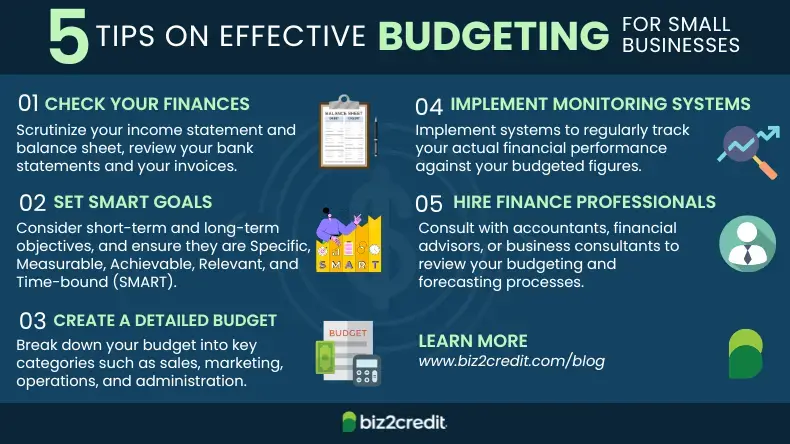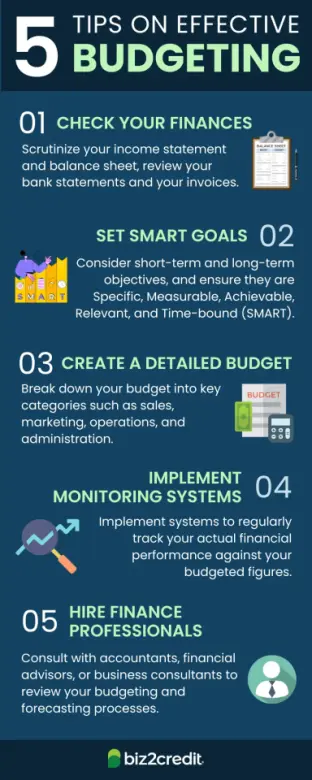A Guide to Effective Budgeting and Forecasting for Small Businesses
In this article:
If you find yourself staring at your books, scratching your head, and wondering where all your hard-earned capital went, it’s more than just a moment of frustration – it’s a signal that it’s time to take budgeting and forecasting seriously.
Running a business is hard work and in the rush to do all the things that a company asks of its owner, sometimes budgeting and financial operations get put on the back burner. In fact, a recent study revealed that 50% of small business owners do not have a well-documented budget. This can lead to painful consequences and could even cost you your business.
If this sounds familiar, don’t worry. This article will address the basics and help you create smart and effective budgeting and forecasting for your small business.
Why Your Business Needs Budgeting and Forecasting
Big corporations and businesses put a lot of resources into coming up with annual and quarterly budgets. They often spend a significant amount of time putting together forecast spreadsheets and budget proposals and then filling out expense reports after the fact. It may seem like a hassle in the moment, but it allows businesses of any size to run efficiently and meet regulatory standards.
As a small business owner, you should be following the same principles for strategic budgeting, even if your processes are a bit simpler. When you do, you’ll be able to stay on top of your cash flow and allocate resources better during periods of surplus and deficit.
Budgets also serve as a guide for achieving financial goals. When you set targets for revenue and expenses, it becomes easier to evaluate your performance against these benchmarks. Many times, you need this evaluation to make decisions about your strategy, marketing, products/services, and even hiring and firing.


A Comprehensive Guide on Effective Budgeting and Forecasting for Your Business
1. Look at Your Current Financial Situation
Getting a handle on your budgeting and forecasting starts with a review of your current financial standing. Scrutinize your income statement and balance sheet, review your bank statements and your invoices. You’ll want to check for errors and make sure that all revenue and expenses are accounted for.
2. Set Clear and Realistic Goals
After you have a clear picture of your current financial situation, the next step is to set clear and realistic goals for your business.
These goals will serve as the foundation for your budget and forecasts. Consider short-term and long-term objectives, and ensure they are specific, measurable, achievable, relevant, and time-bound (SMART).
For example, if you aim to increase revenue, specify the percentage or amount you want to achieve and outline a plan to get there. If cost reduction is a goal, identify specific areas where you can cut expenses.
3. Create a Detailed Budget
Now that you have your goals in place, it’s time to create a detailed budget. Break down your budget into key categories like sales, marketing, operations, and administration. Then, assign funds to each category based on your goals and priorities.
Be realistic in your estimates and use past spending records to inform your projections. Consider factors such as seasonality, market trends, and economic conditions.
Remember that your budget should be flexible enough to accommodate unexpected changes while remaining focused on your business goals.
4. Implement Monitoring and Reporting Systems
Budgeting is not a one-time activity. Neither is forecasting. Both require continuous monitoring and adjustment.
So, here’s what to do. Implement systems to regularly track your actual financial performance against your budgeted figures. This can involve using accounting software and AI tools, creating financial reports, and conducting regular reviews.
Make sure you establish key performance indicators (KPIs) to measure your progress towards your goals. Regularly analyze differences between actual and budgeted figures and identify the reasons behind these discrepancies. Also, keep an open eye on the market to take note of changes in trends and news that could impact your business.
5. Hire Finance Professionals
While you may have a good understanding of your business, seeking professional advice can provide valuable insights and expertise.
Consult with accountants, financial advisors, or business consultants to review your budgeting and forecasting processes.
They can offer guidance on optimizing your financial strategy, identifying potential risks, and ensuring compliance with relevant regulations.
Effective Budgeting and Forecasting for a Sustainable Business
Early in your entrepreneurial journey, you may be able to grow your business without thinking too hard about your finances. But as you scale, you’ll find that they are indispensable to your success. For a business to be sustainable over the long term, your mentality must shift from a focus on personally delivering products and services to a focus on systems and processes that will allow you to grow – and that includes budgeting and forecasting.
As you begin to master your budget, you may find that there is a need for additional financing – either to take advantage of an opportunity, or to cover a seasonal revenue shortfall. Biz2Credit offers financing that can help you keep your business on the path to success.
Want to learn more? You can read success stories from other business owners who used Biz2Credit solutions here.
Comments are closed.